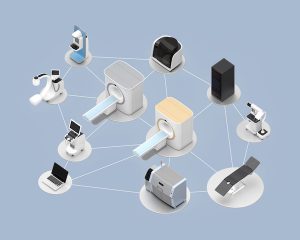Radiological x-rays, ultrasounds and NMR’s are all forms of medical imaging that have traditionally required the flexibility of the human eye to detect anomalies within the human body. Since a computer is confused by busy backgrounds and image quality issues, it is difficult for a traditional machine vision algorithm to locate an object or region of interest with much precision – specifically when it comes to identifying abnormalities amidst an unstructured scene. It can be difficult and time consuming – and sometimes impossible – for an automated system to successfully identify the region of interest while ignoring irrelevant features.
Due to a confusing and poorly contrasted background or other poor image issues, it can be difficult to locate a specific region of interest on an X-ray. However, the combination of deep learning-based image analysis and the flexibility of a human inspector, along with the speed and robustness of a computerized system, is solving this challenge.
Deep learning is a specialized form of machine learning that teaches computers to do what comes naturally to humans: learn by example. Beyond being used in the medical field, deep learning is a key technology behind driverless cars, enabling them to recognize a stop sign or to distinguish a pedestrian from a lamppost. It is the key to voice control in consumer devices like phones, tablets, TVs, and hands-free speakers. Deep learning is getting lots of attention lately and for good reason. It’s achieving results that were not possible before.
In deep learning, a computer model learns to perform classification tasks directly from images, text, or sound. Deep learning models can achieve state-of-the-art accuracy, sometimes exceeding human-level performance.
Because of the accuracy, deep learning-based image analysis can automate the search for biological anomalies reliably and repeatedly. With the data being gathered, it is changing the role of today’s radiologist which can now take advantage of a computer-aided diagnosis (CAD) specifically designed for medical imaging. Combining the flexibility of a human eye with the speed and robustness of a computerized system, anomalies such as a tumor can be more easily spotted.
With today’s robust technology, deep learning-based defect detection and segmentation tools can help identify anomalies quickly and accurately in medical images, on roadways, and will move into other areas of technology as well.
Here at Universe Optics, we offer a wide variety of precision lenses designed specifically for use in the medical field. Our team of engineers, along with our manufac